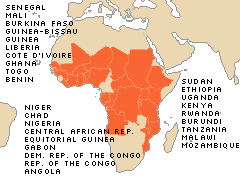
How do we know
A cost-benefit analysis was conducted by the World Bank.Downloads
- Read the entire case study
(PDF | 119 K)
External Links
- View the video "Source of Hope" about the Mectizan Donation Program
- Read more about onchocerciasis and the efforts to control the disease
- Learn more about the history of Mectizan
- View a power point presentation about APOC and OCP
- View public service announcements
- Read impact studies published on the public-private partnership in Mectizan donation and delivery
- Stay informed on the current status of onchocerciasis control
- Read a review of what works in fighting diarrheal disease
- Listen to interview with Dr. Frank Richards on fighting onchocerciasis and other parasitic diseases
Health Condition: Onchocerciasis, or riverblindness, afflicts approximately 42 million people worldwide, with well over 99 percent of its victims in sub-Saharan Africa. An estimated 600,000 people are blind and an additional 1.5 million Africans are visually impaired due to onchocerciasis. In 11 West African countries in 1974, nearly 2 million of the area’s 20 million inhabitants were infected with onchocerciasis, and approximately 200,000 were blind.
Intervention or Program: The Onchocerciasis Control Program (OCP) was launched in 1974 in 11 West African countries. Weekly aerial spraying, with environmentally safe insecticides helped control the disease-vector, – blackflies that bred in fast-moving waterways, thereby halting transmission of the disease. In 1995, a second program, the African Programme for Onchocerciasis Control (APOC), was established to control the disease in 19 Central, East and Southern African countries. Through a broad international partnership and the participation of 115,000 remote, rural local communities, APOC and OCP distributed a drug donated by Merck & Co., Inc., Mectizan, to more than 45 million people in Sub-Saharan Africa in 2005. The drug prevents and alleviates the symptoms of the disease with one annual dose.
Impact: OCP produced an impressive change in health between 1974 and 2002:
- Transmission of the disease-causing parasite was halted in 11 West African countries;
- 600,000 cases of blindness were prevented;
- 22 million children born in the OCP area are now free from the risk of contracting riverblindness;
- About 25 million hectares of arable land—enough to feed an additional 17 million people per annum—is now safe for resettlement;
- APOC is expanding this success to Central, East, and Southern Africa, where 54,000 cases of blindness are expected to be prevented each year.
Cost and Cost-Effectiveness: OCP operated with an annual cost of less than $1 per protected person. Commitments from 27 donors during the 28-year project totaled $600 million. The annual return on investment was calculated to be about 20 percent, primarily attributable to increased agricultural output; about $3.7 billion will be generated from improved labor and agricultural productivity. The annual cost of APOC operations, taking into account the donation of all needed drugs, is approximately $0.58 per person treated.

